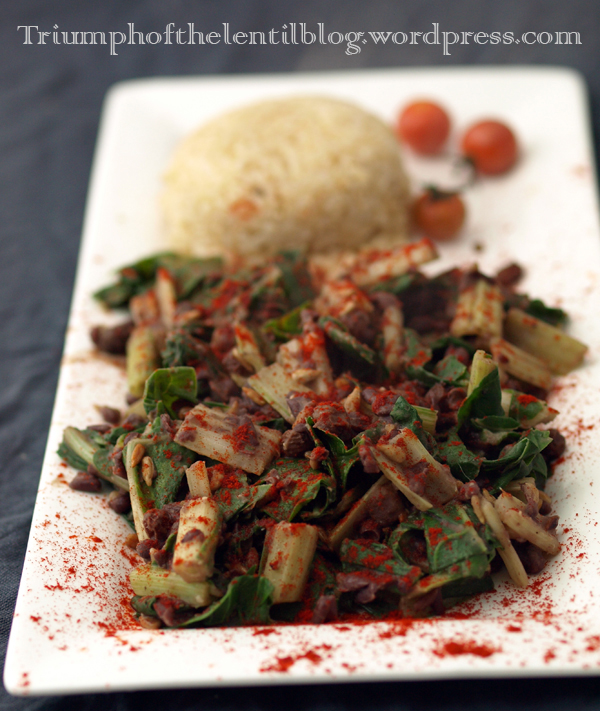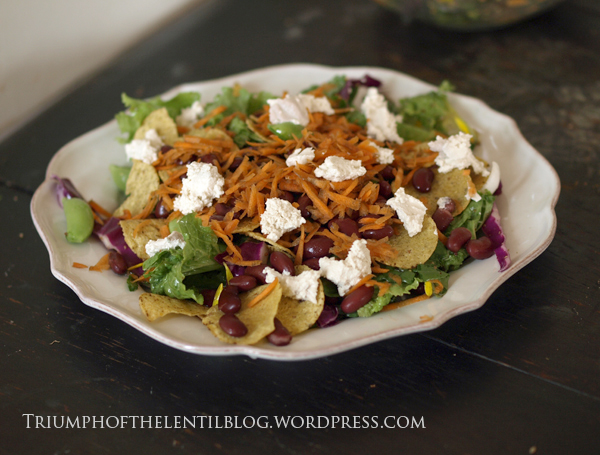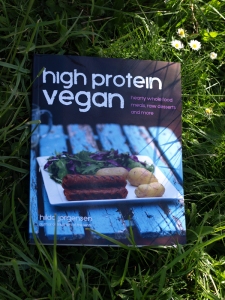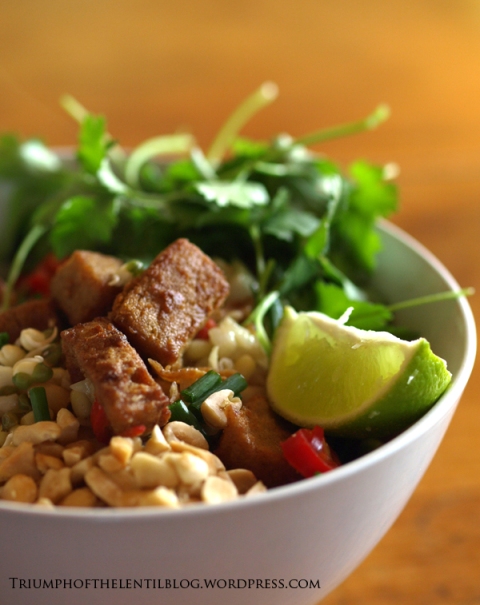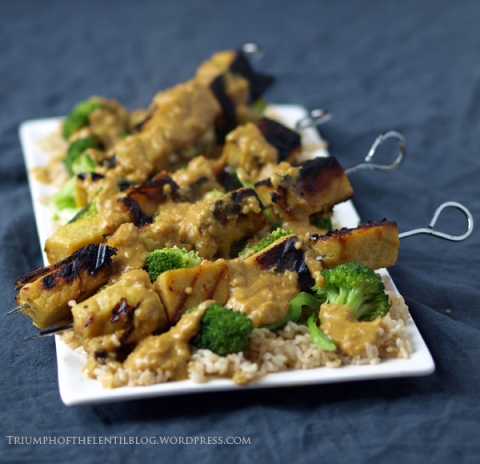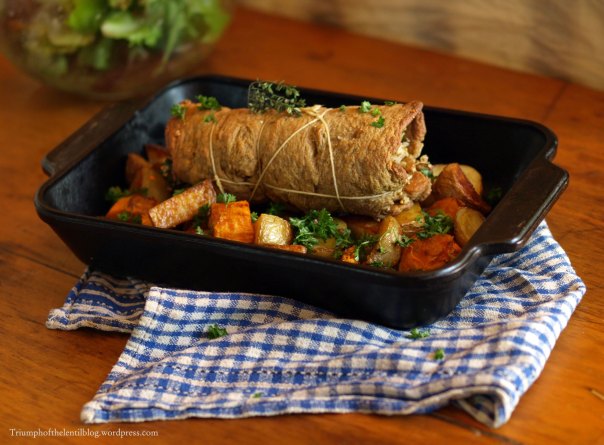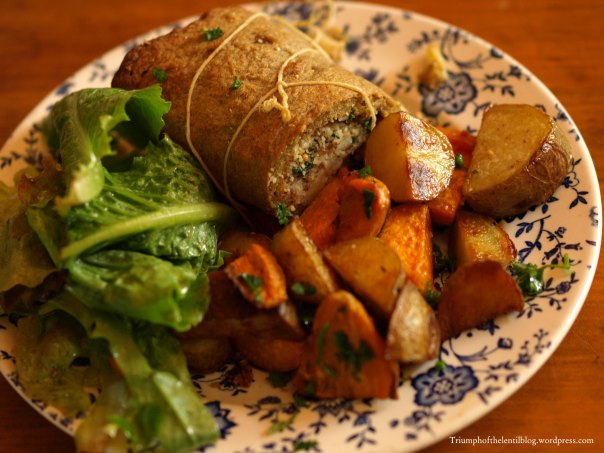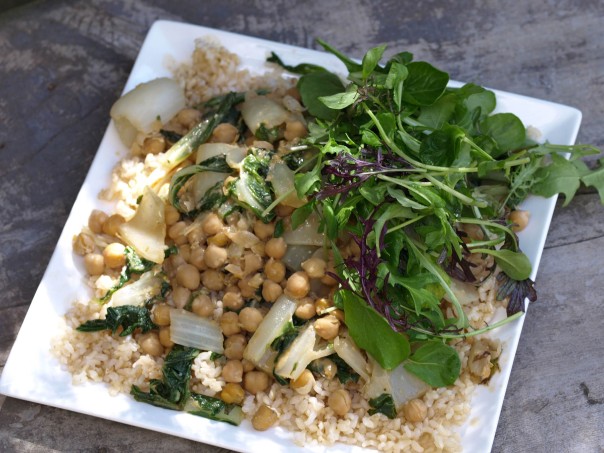Blog Archives
Spanish Chard with Beans, Raisins, Sunflower Seeds and Garlic, plus a cookbook giveaway
Have you ever found a recipe for silverbeet/Swiss chard that you just want to constantly cook? My dolmathes recipe from High Protein Vegan is one of those, but as much as I like it, it takes too much hands-on time for me to want to make it frequently these days. The recipe I’m sharing today (also from my second book), takes minimal time and effort, and people that don’t usually appreciate leafy green veggies enjoy this one.
Silverbeet/Swiss chard is really easy to grow in the garden – I didn’t appreciate it much until I started growing it because it seems a lot more dependable where I live (compared to kale which gets eaten by aphids here). In colder climates chard dies in the winter, but here it grows right through winter, and bursts into leaf in spring, providing a lot of leafy greens for very little effort.
Giveaway time:
Before I share the recipe I would like to offer a copy of High Protein Vegan as a giveaway prize – in celebration of it being released one year ago. This is the first ever cookbook to focus on high protein vegan recipes and it’s had some great reviews so far.
To participate in the giveaway, sign up on the right hand side of this blog for the Triumph of the Lentil blog mailing list, ‘like’ my Facebook page or follow me on Twitter and leave a comment on this post – then on the 1st of December I’ll use a random number generator to pick a comment. If you’ve already signed up to follow this blog by email, facebook or twitter you’re also welcome to enter the giveaway.
The giveaway is now closed. The winning comment is:
About the recipe:
This is an incredibly tasty way to eat a lot of greens in one meal with a little sweetness from the raisins, crunch from the chard stems and umami flavours from the smoked paprika and miso.
I like to serve this with brown rice or other cooked wholegrains (use quinoa for a really fast meal) but bread or roasted veggies are also good choices.
Gluten-Free Option*, Soy-Free Option*, Grain-Free Option**, Nightshade-Free Option, Nut-Free, Under 45 MInutes
Serves 2
Ingredients:
1/2 cup water, for soaking raisins
4 tablespoons raisins or sultanas
4 tablespoons sunflower seeds
1 bunch swiss chard or silverbeet (around 500g/1.1lb)
1-2 tablespoons olive oil
3 large cloves of garlic, thinly sliced
1 1/2 cups cooked azduki, borlotti or pinto beans
1-2 teaspoons miso, tamari or coconut aminos
optional salt, to taste
optional smoked paprika, to taste
Method:
Bring the water to the boil, take off the heat and soak the raisins in it while you prepare the rest of the dish.
Toast the sunflower seeds in a dry frying pan over medium heat, stirring frequently until golden. Set aside.
Cut the chard, including the stalks into one inch (2.5cm) pieces.
Heat the olive oil in a frying pan and sauté the garlic until golden. Add the chard and sauté for one minute. Stir through the beans until the chard is wilted and the beans are hot. Drain the raisins and add these, along with the sunflower seeds. Adjust the seasonings with miso and smoked paprika. Serve right away.
*be sure to choose a soy-free and/or gluten-free miso, or use coconut aminos instead
**use coconut aminos instead of miso
This post is a part of Wellness Weekend, Pennywise Platter, Healthy Vegan Fridays and Waste Not Want Not Wednesday
Homemade Vanilla Extract

Good quality vanilla extract can be really expensive, and the shop I usually buy it from is often out of stock. But now that I know how easy it is to make at home, I’ll never buy it again. This recipe is so easy, and tastes even better than shop-bought extract.
If you buy organic vanilla beans in bulk (200g (7oz) of them is around 53 beans) it works out to be less than $5 for the vanilla beans, plus the cost of the vodka. Even using good vodka this ends up being half the price of what I used to pay for shop bought extract. (Cheap and nasty vodka will also work in this recipe).
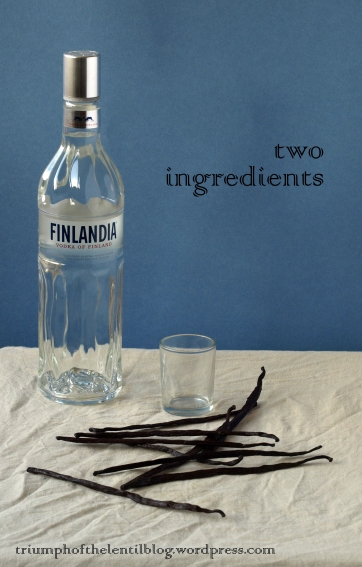
Ingredients:
Around 700ml (23oz) vodka
9 vanilla beans
Method:
Pour a little of the vodka out (around 1 or 2 shots worth), save it for later or drink it.
Slice the vanilla beans lengthways in half. Scraping out some of the pulp and adding this to the vodka will make for a stronger vanilla extract.
Carefully place the vanilla beans and the pulp in the bottle of vodka. Put the lid on and leave it to infuse in a dark cupboard for around two months. To speed up the process turn the bottle upside down, then right side up every so often…this means you can use your extract after a month.
When the vanilla extract is ready either remove the beans and put it into smaller bottles (it makes a nice gift), or simply keep it in the vodka bottle with the vanilla beans.
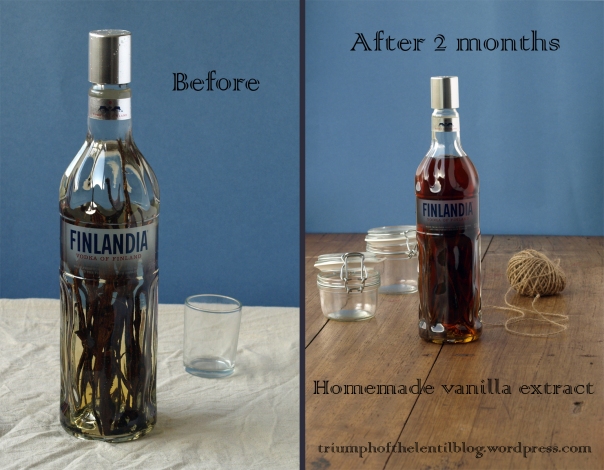
Nacho Salad
I like to eat salads for meals every now and again, typically if they have plenty of protein, fat and some carbs to make it more filling. This is a salad which has all of these things, but according to my other half it shouldn’t be called a salad, just ‘nachos’. Whatever it’s called, this is a satisfying meal that’s fast and easy to make, and perfect for hot weather.
Total time 10-15 minutes
Gluten-Free, Soy-Free, Nightshade-Free, Onion- and Garlic-Free Option, Under 45 Minutes
Serves as many as you want
Ingredients:
Dressing of your choice (for 2 adults and 2 children I use 3 tablespoons olive oil, 1 tablespoon apple cider vinegar, 1/2 tablespoon raw agave syrup, 1/2 tablespoon seeded or dijon mustard)
Leafy greens (eg. lettuce, rocket (arugula), miners lettuce, mizuna, mustard greens)
Heartier raw vegetables (eg. cabbage, kale, grated carrot, sugar snap peas, green beans)
Optional fresh herbs such as oregano and coriander leaves (cilantro)
Corn chips, or extra grated carrot
Cooked or sprouted beans
Optional extras such as avocado, vegan cheese, salsa, spring onion (green onion)
Method:
Mix the dressing in a large mixing bowl. Add the greens, veggies and herbs and toss to thoroughly coat. Put layers of the dressed salad, corn chips, beans and any extras on large plates and serve right away.
In the photo I’ve used lettuce, rocket (arugula), sugar snap peas, red cabbage, grated carrot, corn chips, cooked red kidney beans, and the basic cashew cheese from ‘Artisan Vegan Cheese’.
Raw Caramel Slice, and an announcement
My new book is out – the first ever high protein vegan cookbook, titled ‘High Protein Vegan: Hearty Whole Food Meals, Raw Desserts and More’. It’s available now from the places listed on this page and I’d like to share one of my favourite recipes from it.
To give you an idea of what it looks like in the book:

Raw Caramel Slice
Gluten-Free, Soy-Free, Nightshade-Free, Onion- and Garlic-Free, Under 45 minutes
Kitchen time 10-15 minutes, Setting time: 30-60 minutes
A raw vegan version of an old favourite with a chewy caramel filling and thin chocolate topping, this slice is delicious and tastes a little bit like caramel nougat chocolate bars, only better. It can be made as a slice in a square pan, or as a torte in a round springform tin. For best results use almonds for the base, although walnuts or pecans will also make a great slice.
I recommend using refined coconut oil for this recipe.
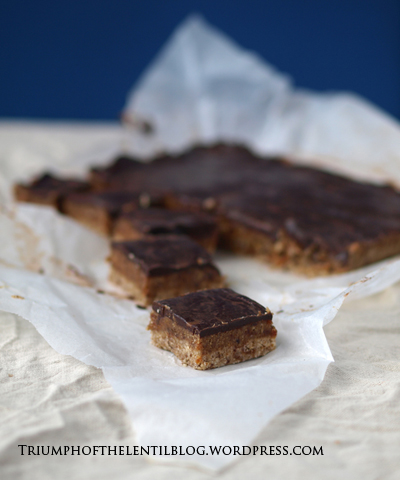
Ingredients
For the base:
1 1/2 cups almonds, walnuts or pecans
a pinch of salt
4 medjool dates, pitted
1/3 cup coconut oil, liquid
For the caramel filling:
18 medjool dates, pitted
2-3 pinches of salt
1/4 cup coconut oil, liquid
1/4 cup nut butter (hazelnut, almond, cashew or brazil nut)
For the chocolate topping:
1/4 cup coconut oil, liquid
a pinch of salt
2-3 tablespoons raw agave syrup
1/2 cup cacao or cocoa powder
Method
To make the base, process the almonds and salt in a food processor until crumbly, but not too fine (some will resemble almond meal, and some will be more like the nut pieces that go into pesto). Add the dates and process until no large pieces remain. Process through the coconut oil until evenly mixed in. Press the mixture into a greased or lined 20cm (8”) square or round baking tray.
To make the caramel layer, process the dates and salt in a food processor until it is finely ground and forms a ball. Add the coconut oil and nut butter and continue to process until thoroughly mixed through (you may need to stop the processor and break up the ball with a fork a couple of times). Press this mixture into an even layer on top of the base.
Prepare the chocolate topping by combining the coconut oil, salt and agave in a bowl. Stir through the cacao and mix until evenly combined, adding more agave if you like. Spread this on top of the caramel layer (you may need to use your hands to spread it) and allow to set at room temperature for at least half an hour before slicing, or until the chocolate topping has set.
What to expect from ‘High Protein Vegan’:
•Innovative ways to serve legumes and vegetables
•Better photos: since writing my first book I’ve learned more about working with natural light and put extra effort into composition and styling, along with upgrading my lens. All the photos in this book are taken with natural lighting.
•Vegan sausages! Bratwurst, Kransky, Frankfurter and more…
•Soy-free tofu, and recipes to use it in
•Raw desserts and raw meals, all without a dehydrator
•All the answers you’ll need for when people ask “where do you get your protein?”
•Recipes to impress anyone, for a variety of occasions
Similar to ‘Triumph of the Lentil’, this book also has:
•Minimal premade products – recipes totally from scratch including laksa and Thai green curry – make meals easily from fresh ingredients, with a taste that is superior to using shop-bought pastes.
•Soy-free options for all recipes. While the book itself is not soy-free in that it doesn’t specify to use soy-free miso or soy-free vegan milks, the soy allergy of my main taste-tester means that all the recipes have been made using soy-free ingredients.
•Mostly gluten-free recipes
•Cook-friendly, frustration-free layout – I like to cook from cookbooks and designed this one with how I want a cookbook to be – easily readable recipes from a distance, with the ingredients and instructions on the same page.
•Colour photos with nearly every recipe
•Whole foods – no refined grains, margarines or ‘fake’ things in sight.
•Index by ingredient – make use of seasonal vegetables and whatever cooked legumes you have on hand
•Recipes suitable for small households – many recipes make 2 servings, while all other recipes make more servings that reheat well or can be stored uncooked in the fridge for cooking up later.
•Lots of everyday recipes – these were all tested with two young children to look after and mostly with ingredients that I can find locally though the whole year. I don’t have the time to spend hours in the kitchen for every meal and have timed every recipe to show just how little hands-on kitchen time some of them take.
•Real meal recipes – This is the stuff I cook at home – not a bunch of appetisers, fancy breakfasts and complicated side dishes but mostly hearty recipes that are either meals on their own, or completed with a very simple side dish.
For more information about the book, see http://highproteinvegan.wordpress.com/
This post has been shared with Allergy-Free Wednesday, Wheat-Free Wednesday, Whole Food Wednesday, Pennywise Platter, Wellness Weekend, Raw Foods Thursdays and Healthy Vegan Fridays
Soy-Free Tofu
When I’m working on books I never really know what recipes to share on the blog, and what can wait for the book. This is something I knew I had to share right away.
It’s not the same as soy tofu – it doesn’t have the same texture or taste, but it is a protein-rich medium for all kinds of delicious sauces (like chermoula, pictured above), or to be fried up and used in a variety of recipes, like the grain-free pad thai from my next book, pictured below.
It can also be cut into chip shapes, shallow fried and enjoyed as a high-protein alternative to potato chips, to turn a chip sandwich into a balanced meal.

I’ve based my recipe around a combination of things – Burmese tofu has been traditionally made with chickpea flour for a long time, but typically involves a lot of prep time and tricky steps, and while this would reduce the phytic acid in the tofu, it makes the process a lot slower. With my recipe the tofu can be ready to use in under 45 minutes. If you’re good with planning ahead and want to make the tofu as nutritious as possible then the batter can definitely be soaked for 8 hours or more before heating it up, otherwise enjoy this cheap, fast and tasty homemade alternative to tofu.
Soy-free, gluten-free, nut-free, low fat, nightshade-free, onion- and garlic-free, under 45 minutes
Makes 4-6 serves
Ingredients:
2 1/2 cups chickpea flour (besan)
1 teaspoon salt
4 cups cold water
Method:
Line or grease a 20x30cm (8×12″) pan.
In a heavy-bottomed chef’s pan, frying pan or saucepan place the chickpea flour and salt, and squash out any lumps. Add water a little at a time, making sure that no lumps form.
Turn on the heat to medium and stir continuously until very thick. I make this on an electric stove in a 9 1/2″ (24cm) chef’s pan and it takes around 7 minutes. If you’re using a gas stove it will be quicker, if you’re using a smaller saucepan it will take longer.
As soon as the mixture is very thick, quickly spread it into the prepared pan, pressing to form a flat, even surface (it will set very quickly). Leave to set for at least half an hour before using as tofu.
To remove from the pan first slice into whatever shape you want them to be, and gently lift up. I find that lining the pan with a silicon baking mat or some baking paper makes it a lot easier to remove.
This will keep in the fridge for up to a week and can be used in all kinds of recipes that call for tofu.
This post has been shared on Pennywise Platter, Wellness Weekend, Whole Food FridaysandHealthy Vegan Fridays
One year of Triumph of the Lentil, a giveaway, and soy-free vegan omelettes
It’s been nearly a year since my first book was released. At the time I had no idea if anyone would want to buy it and cook from it but it’s been great having good feedback on it and knowing people are cooking and appreciating my recipes.
When I started putting Triumph of the Lentil together there were no soy-free vegan cookbooks around. As more people develop sensitivities to this often-used legume it’s been important to me to have something out there that says “yes you can be vegan and enjoy all this delicious food without using soy”. My next book will continue this, with every recipe having a soy-free option, and plenty of recipes suitable for other allergies and diets.
I’d like to give away a copy of Triumph of the Lentil to a lucky reader. To enter the competition, ‘like’ the Triumph of the Lentil Blog facebook page or follow me on twitter, or sign up to the mailing list on the right hand side of this page. Leave a comment on this post with an email address I can contact you on. On the 15th of June the winner will be selected from the comments at random and contacted.
Edit: The winner has now been selected and contacted. Thank you to all those who entered.
To everyone that has already signed up to my facebook, twitter or mailing list – you are welcome to enter the competition, just leave a comment on this post. Your support has been greatly appreciated.
Thank you to everyone that has enjoyed the book and blog over the past year, I hope that you will all like my next one even more.
And now for a recipe:

Soy-Free Vegan Omelettes
These are a very quick and easy dish to make. In the photo the omelette is stuffed with kale, tomatoes and homemade cashew cheese, but all kinds of toppings are great on these omelettes, we often eat them with pickled gherkin slices and kale. For a filling meal serve with cooked grains, bread, chips or roasted vegetables.
Soy-Free, Gluten-Free, Nut-Free, Nightshade-Free, Onion- and Garlic-Free, Low Fat, Under 45 Minutes
Total time: 20 Minutes. Serves 2.
Ingredients:
1 cup chickpea flour (besan)
3 tablespoons nutritional yeast (savoury yeast flakes)
1/2-1 teaspoon salt
1 teaspoon cracked pepper
1 cup water
Method:
Combine the chickpea flour, nutritional yeast, salt and pepper in a mixing bowl, breaking up any lumps. Add the water a little at a time, mixing to form a batter.
Thoroughly brush or spray a frying pan with olive oil and heat on a medium-high setting. When the pan is hot, pour in half the batter (if it is thicker in the centre and thinner on the outsides you can use the back of a metal spoon to gently spread the batter out).
Cook without disturbing until the edges are cooked through and there are bubbles in the middle. Gently flip over and cook for a further minute or two, until the other side is completely cooked. Place on a plate, keeping it warm in the oven if you wish.
When the first omelette is out of the pan, quickly pour the other half of the batter in and cook in the same way.
Put toppings on one half of each circle and flip the other side over the top.
This post has been a part of Allergy-Free Wednesdays.
Chickpea and Gherkin Smørrebrød
I said I would post another recipe for using homemade vegan mayonnaise soon and here it is. After formatting the Triumph of the Lentil Kindle edition, cooking celebration meals, and editing my wilderness photos for sale as calendars, cards and prints, I now have a moment to post about smørrebrød.

Smørrebrød is a Danish open-faced sandwich, and is perfect for using slices of hearty wholegrain breads that aren’t so great for using in a two-slice sandwich. In Denmark it’s traditionally made from a dark rye sourdough, but I use my 100% wholemeal wheat bread with great results. Traditionally butter is spread on the bread (that’s what ‘smørre’ means), but I’ve used homemade vegan mayonnaise on mine.
There are heaps of different traditional toppings which are definitely not vegan, and although I never ate the ‘real’ thing in Denmark, I think these ones I’ve made topped with salad greens, chickpea salad and pickled gherkin slices resemble them.
Kitchen time 5-10 minutes. Serves 2.
Soy-free, onion- and garlic-free, nightshade-free, no speciality ingredients
Ingredients:
4-6 slices fresh wholemeal bread (preferably rye, or my wholemeal wheat bread recipe)
homemade vegan mayonnaise
salad greens
1 1/2 cups cooked chickpeas (1 400g (14oz) tin, rinsed and drained) (use 2 1/4 cups if you’re extra hungry)
pickled gherkin slices
Method:
Spread some vegan mayonnaise on the bread. Mix the salad greens with some more vegan mayo and place this on top of the bread. Using a fork, mash the chickpeas with plenty of vegan mayonnaise and cover the salad greens with this. Top with gherkin slices and serve right away.
Seitan Roulade with Parsley Root Stuffing
We haven’t had many celebration-worthy meals of late, instead falling back on many of our comforting favourites from Triumph of the Lentil (especially the lentil lasagne, penne pasta bake and seitan ‘steak’ with onion and pepper gravy) while I focus my kitchen creativity on baking for my next book. With the release of the Kindle edition of Triumph of the Lentil and it quickly reaching #1 bestseller status in Germany for English language Natural Foods cookbooks, a need for a tasty celebration meal arose.
The Kindle edition is available from Amazon.com, Amazon.de, Amazon.co.uk and Amazon.fr
Parsley root is a strange looking and delicious vegetable. I grow my own but if you’re lucky you might find some of these at a farmer’s market or CSA from late summer to early spring, depending on your climate. Growing it is pretty much the same as parsnip, but the seeds sprout a little easier, it’s also sometimes sold as “Hamburg parsley”.
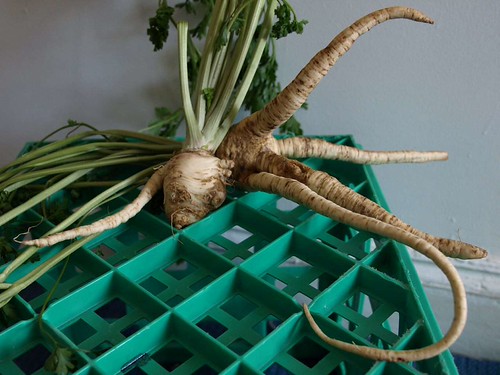
With this recipe it’s possible to have an impressive meal to serve to guests in under an hour. It can also be made ahead and stored in the fridge until baking, perfect when you’re having friends over and want to spend time with them rather than rushing around cooking stuff.
This stuffing is really unique and tasty. It’s grain-free, so people on gluten-free or grain-free diets could use this instead as stuffing for a nut roast or lentil loaf.
Kitchen time 15-20 minutes. Makes 4 serves. (if you’re cooking for less people, the other rolled and tied-up roulades can be kept unbaked in the fridge for up to 5 days and baked when needed). Best served with roasted veggies, miso gravy (recipe below) and a green salad.
Soy-free, Onion- and garlic-free, nightshade-free (depending on your worcestershire sauce ingredients)
New improved baked seitan mixture (makes 4 serves)
Dry ingredients:
1 1/4 cups gluten (vital wheat gluten)
1/3 cup chickpea flour (besan)
2 tablespoons nutritional yeast (savoury yeast flakes)
1 teaspoon salt (omit if using tamari)
Wet ingredients:
2 tablespoons vegan worcestershire sauce, soy-free tamari or coconut aminos
2 tablespoons oil (olive, sesame or sunflower)
1 cup water
Method:
Combine the dry ingredients in a mixing bowl. Add the wet ingredients stirring, and then kneading to combine. Leave to rest for at least 5 minutes.
Parsley Root (or celery root, or parsnip) Stuffing
Ingredients:
2 cups finely diced parsley root, celery root or parsnip
1/2 cup hazelnut meal or almond meal
2 tablespoons dijon mustard (or 2 teaspoons yellow mustard powder plus 2 tablespoons water)
2 tablespoons fresh thyme, or 2 teaspoons dried
optional 4 tablespoons finely chopped fresh parsley
optional pinch of salt and 1 teaspoon apple cider vinegar (add if using mustard powder instead of mustard.)
Method:
Preheat the oven to 160-200c (320-390f).
Prepare the seitan mixture from the directions above and set aside to rest for at least 5 minutes. Prepare your side dish and stuffing ingredients while it rests and the oven heats up.
Grease a baking sheet and stretch the seitan out into as large a rectangle as you can without it breaking (if you want to make two or four roulades instead of one, divide the mixture into pieces and then stretch it and bake). Place on the sheet and continue to press it out until it gets bigger, without it breaking. It should be less than 1cm (1/2″ thick).
Brush the top with oil and bake for 7 minutes.
Bring a tiny bit of water to the boil in a small pot, then add the parsley root and boil for 5 minutes. Drain.
In a mixing bowl, mix the parsley root, hazelnut meal, mustard, thyme and parsley together.
Place the least browned side of the seitan down on a plate and place the parsley root mixture in the middle third of the rectangle. Roll the shorter end towards the other shorter end, overlapping it a little bit. Tie it up with cotton string and stuff any of the fallen-out stuffing back in it. Leave it seam-side down until you’re ready to cook it.
When your roasted veggies have 20 minutes to go, place the seitan on the same tray as them, or a separate greased tray, and brush liberally with oil. Bake for 20 minutes.
Miso Gravy
This gravy really compliments the crispy seitan, which is a little dry on its own, and is delicious with roasted potatoes.
Serves 4. Kitchen time 5 minutes.
Soy-free option, gluten-free option, low fat option, nightshade-free
1 medium onion
4 tablespoons flour (whole barley, spelt, wheat or gluten-free)
2 cups water
3 tablespoons miso*
3/4 teaspoon dried thyme (or 2 teaspoons fresh)
1/4 teaspoon dried sage (or 3/4 teaspoon fresh)
1/4 teaspoon dried rosemary (or 3/4 teaspoon fresh)
cracked pepper, to taste
1/2 teaspoon balsamic vinegar
Place the onion in a frying pan with a little olive oil, stirring to coat. Put on a medium-high heat and continue to stir until the onions are tender and fragrant and starting to brown. Stir through the flour, then stir through the water, a little at a time so that no lumps form. Add the miso, herbs, pepper and vinegar and bring to the boil. Reduce heat and simmer for at least 5 minutes.
*For details on soy-free and gluten-free miso, see this post.
Quick and Easy Bok Choy (or Cabbage) and Chickpeas with Miso and Balsamic Dressing
Inspired by this recipe I bought some bok choy and adapted the recipe into a main course to feed two hungry people. I imagine that this recipe would be also be really tasty using cabbage or broccoli instead of the bok choy.
The dressing is so savoury and delicious that I often now make a salad dressing based on it by mixing 3-4 teaspoons of olive oil, 1 teaspoon of balsamic vinegar, 1 teaspoon of miso and half a teaspoon of mustard in a salad bowl, then stirring through some raw salad greens.
Gluten-free option, low fat option, nightshade-free, onion- and garlic-free, soy-free option, under 45 minutes
Kitchen time 10 minutes
Serves 2
Ingredients:
Brown rice, or some other grain for two (I used 1 1/4 cups of rice)
1 large bunch of bok choy, or other greens
2 1/4 cups cooked chickpeas (1 1/2 400g (14oz) tins, rinsed and drained)
1/2 cup water
1 1/2 tablespoons mellow light miso*
1 1/2 tablespoons balsamic vinegar
1 tablespoon olive oil or water
Cook the grains. (For brown rice: Rinse and drain, then add 1 1/2 to 2 cups of water per cup of rice. Bring to the boil, reduce heat and simmer with the lid on 25-30 minutes, take off the heat and leave to stand for 10 minutes.)
While the grains are cooking, prepare your vegetables and chickpeas by rinsing and drying them. Chop the bok choy into pieces around 3cm (1 inch) long, placing the stems in a separate bowl from the more leafy parts. Make the dressing by combining the miso, balsamic vinegar and 1 tablespoon olive oil in a small bowl.
When the grain has been standing off the heat for 5 minutes, heat a heavy chef pan or stockpot over a high heat. When the pan is hot, add 2-4 teaspoons of olive oil and quickly throw in the bok choy stems first, then add the chickpeas and bok choi leaves. Don’t stir. Put the lid on and cook for 2 minutes without stirring or lifting the lid.
Add half a cup of water to the pan and stir through. Put the lid back on and cook for another 2 minutes. Taste some of the bok choy to see if it’s cooked enough and cook for a little longer if needed. Take off the heat and stir through the dressing. Serve right away on top of the grains.
*Miso is typically made from fermented soybeans, but there are people around that make soy-free miso. I used a soy-free (and gluten-free) chickpea and brown rice miso made by Blue Mountains Miso in Australia. In the US the South River Miso Company make some soy-free misos and can post worldwide.
